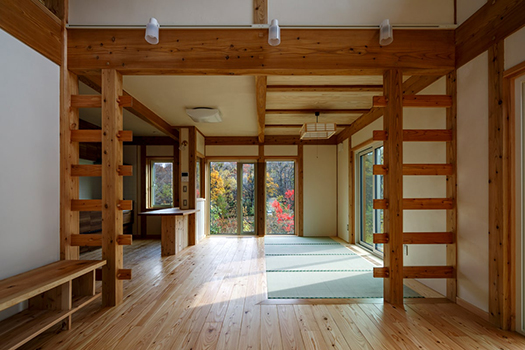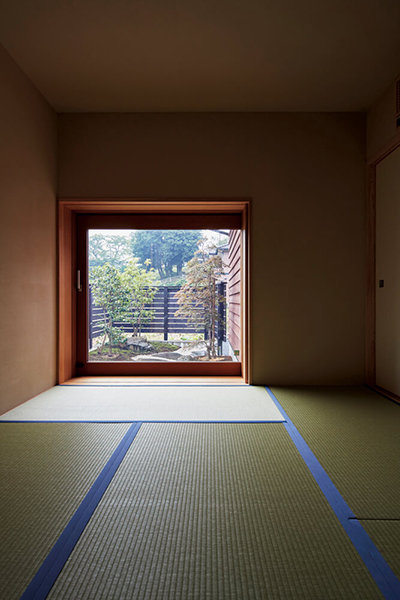

どうもここのところ興味分野が内面的になってきているかもしれない。
家の意味合いという本質的な部分でしょうか。
空間としての機能性というものでは生存維持と自己DNAの世代更新、
子育ての安全環境を作り出すということが家というものの基本目標。
人間という生物存在は完全に成長するまでには20年近い長い時間を必要とする。
その間は親の世代がその安全環境を保障するのが自然。
意識するかしないかは問わず、このことが最大の目標になる場合が圧倒的だった。
一方で単身での人生選択の結果を反映した家づくりも広がってきている。
このことが人間の家づくりの意味合いを根底的に変えるのかどうかは
まだ趨勢をしっかり見定めていかなければならない。
子育てという目標とそれがない場合の違いというのは、
まだ十分に体系的に把握できない段階なのではないか。
今後、こういう部分も探求されていく必要はあると認識している。
そういう人間生活論とは別に、機能性としての住宅では
窓の開け方というのが最大の興味分野になることは間違いが無い。
より大きくは地域環境そのものを選択するという前提条件があり、
この部分から大きな仕分けができていくのだろう。
しかし一般的にはそういう選択以降、周辺環境との「対話」について
窓の開け方、風景の切り取り方というのが重要なファクターになる。
ここで北海道の場合には周辺環境の風景密度が広い、という与条件がある。
「なにもない空間」という部分が大きいと思う。
冬の堆雪場所を確保せざるを得ないことから、このことが必然化する。
建物間隔であったり、道路の空隙領域が相対的に広く取られるということ。
このことが窓の切り取り方にも大きく影響してくる。
札幌のような都市集住環境でも「視線が抜けて行く」感覚は強くある。
北海道以外の地域では「見たくない」外部環境の中、見たい環境造営として
庭造りの需要が高まるけれど、北海道では必ずしもそうではない。
なんといっても圧倒的な風景の広がりが担保されていることから、
そこまでは人工に頼らないという風土性が存在する。
首都圏に暮らした経験からするとまず雲の生成、様子自体が全然違うと思う。
はじめて海外に行ったとき「あ、雲が違うなぁ」と感じたけれど、
大きな地域環境要因での相違が大きいのだと思っている。
もちろんそれぞれの地域でそれぞれの圧倒的美感はあるのだけれど、
それよりも周辺環境的「狭さ」がより強く感じてしまう。
北海道もやがて本州化して意識的に周辺環境を創造する必要性が高まるのかどうか、
まだ、人口密度がそこまでになっていないので、意識化されていない。
窓の開け方、風景の切り取り方にあっけらかんとして対応しているのだろうか。
高断熱高気密という性能要件以上に案外この部分が、
北海道とそれ以外の地域の家づくりの意識の決定的違いなのかもしれない。
全国規模の住宅コンクール審査を依頼されそうなのですが、
そういうこともきっかけにして、こんなテーマについても
家づくりのメンタルの部分での文化的相違として考えて見たいと思っている。
English version⬇
[The relationship between the place where humans live and the outside world.
Each region has significant differences in cloud production and the sense of landscape. The balance between the man-made environment and the local environment created by clouds. We would like to consider the human environment from this perspective. ・・・・・.
Apparently, my field of interest may be becoming more internal these days.
Is it the essential meaning of a house?
In terms of functionality as a space, the basic goal of a house is to maintain survival, to renew one’s DNA generationally, and to create a safe environment for raising children.
The basic goal of a house is to create a safe environment for raising children.
A human being needs nearly 20 years to fully develop.
During that time, it is natural for the parents’ generation to guarantee a safe environment for their children.
Whether consciously or not, this was overwhelmingly the primary goal in many cases.
On the other hand, there is a growing trend toward home building that reflects the results of single life choices.
Whether this will fundamentally change the meaning of human home building remains to be seen.
We still have to closely monitor the trend.
The difference between the goal of raising a child and the goal of not raising a child is still a stage that cannot be fully systematically grasped.
The difference between the goal of child rearing and the absence of child rearing cannot yet be fully systematically grasped.
We recognize the need to explore this aspect in the future.
Apart from such a theory of human life, the way windows are opened is the most interesting aspect of housing in terms of functionality.
The way windows are opened is surely the area of greatest interest.
The larger premise is the selection of the local environment itself.
This is where the major sorting takes place.
In general, however, after such a selection, “dialogue” with the surrounding environment
The way windows are opened and the way landscapes are cut off are important factors.
In the case of Hokkaido, the density of the landscape in the surrounding environment is very large, which is a prerequisite.
The “empty space” is a major factor.
This is inevitable because it is necessary to secure a place to store snow in winter.
The space between buildings and the road space is relatively wide.
This also has a significant impact on the way windows are cut.
Even in an urban residential environment such as Sapporo, there is a strong sense of “the line of sight slipping away.
In areas outside of Hokkaido, the demand for garden construction is increasing as a way to create an environment that people want to see in the midst of an external environment that they “don’t want to see.
In Hokkaido, however, this is not necessarily the case.
After all, the overwhelming expanse of the landscape is guaranteed.
However, this is not necessarily the case in Hokkaido.
Having lived in the Tokyo metropolitan area, I can say that cloud formation and the appearance of clouds themselves are completely different.
When I went abroad for the first time, I felt “Oh, the clouds are different.
I believe that there is a big difference due to environmental factors in each region.
Of course, each region has its own overwhelming sense of beauty.
I felt more strongly the “narrowness” of the surrounding environment.
I wonder if Hokkaido will eventually become more like Honshu, and whether the need to consciously create the surrounding environment will increase.
Since the population density has not yet reached that level, it has not yet been made conscious.
Are they responding to the opening of windows and the cropping of landscapes in a straightforward manner?
More than the performance requirement of high thermal insulation and airtightness, this part of the house is more important than one might think.
This may be the decisive difference in the awareness of house building between Hokkaido and the rest of Japan.
I’m about to be asked to judge a nationwide housing competition.
That is also a good opportunity for me to discuss such a theme as well.
I would like to consider and see this as a cultural difference in the mentality of house building.
Posted on 11月 6th, 2022 by 三木 奎吾
Filed under: こちら発行人です, 住宅マーケティング







コメントを投稿
「※誹謗中傷や、悪意のある書き込み、営利目的などのコメントを防ぐために、投稿された全てのコメントは一時的に保留されますのでご了承ください。」
You must be logged in to post a comment.